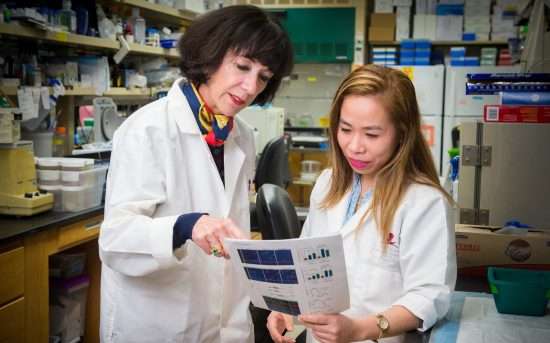Scientists identify protein interaction that defines an aggressive brain tumor subtype

Scientists at St. Jude Children's Research Hospital and the University of Würzburg in Germany have identified a protein interaction that is a hallmark of an aggressive subtype of medulloblastoma and that may provide a new treatment strategy. The research appears today in the scientific journal Cancer Cell.
The results also answer a question that has puzzled researchers: Why the proteins Myc and MycN, which were generally considered to be interchangeable, lead to two distinct subtypes of medulloblastoma when overexpressed in developing neurons. The subtypes - group 3 and sonic hedgehog (SHH) - are among four that make up medulloblastoma, the most common malignant childhood brain tumor.
Working in genetically engineered mice, researchers showed that the Miz1 protein plays a pivotal role in determining tumor identity. Investigators demonstrated that is because Miz1 binds effectively with Myc but not MycN. The resulting Myc-Miz1 complex binds to DNA, altering gene expression to drive the growth and spread of group 3 medulloblastoma rather than the SHH or other subtypes.
"This study not only demonstrates that the Myc-Miz1 interaction is required for development of group 3 medulloblastoma, but also showed that inhibition of that interaction dramatically reduced the tumor's aggressiveness," said Martine Roussel, Ph.D., a member of the St. Jude Department of Tumor Cell Biology. She and Martin Eilers, Ph.D., University of Würzburg, are co-corresponding authors.
"The findings suggest it may be possible to suppress the spread of group 3 tumors using small molecules to target Miz1 and inhibit binding with Myc," Roussel said. At St. Jude, the drug discovery effort has begun.
The group 3 subtype accounts for about 25 percent of medulloblastoma cases and usually occurs in infants and toddlers. About half of group 3 patients are alive five years after diagnosis, which makes group 3 the subtype with the worst prognosis. In contrast, about 75 percent of patients with SHH medulloblastoma become long-term survivors. The SHH subtype is named for the SHH signaling pathway, which is abnormally activated in tumor cells. About 30 percent of medulloblastoma patients, usually children less than 3 years old and adults, have the SHH subtype.
Previous research from Roussel and others showed that overexpression of Myc in developing brain cells called granule neuron progenitors induced group 3 tumors, while overexpression of MycN in granule neuron progenitors led to the SHH subtype. The finding was puzzling because Myc and MycN belong to the same family of proteins and play important roles in a variety of cell processes, including growth, differentiation, death and tumor formation.
This study helps to explain why. Researchers showed that the Myc/Miz1 complex drives group 3 tumors by repressing expression of genes in the SHH pathway. The affected genes encode for transcription factors like Atoh1 and Foxg1, which are involved in normal development, differentiation and survival of neurons. The suppression helps group 3 tumors cells remain more like stem cells in their ability to divide and proliferate.
The Myc/Miz1 complex blocked expression of genes responsible for assembling the antenna-like projections called primary cilia that play a key role in cellular communication. Group 3 tumors in mice and humans lack primary cilia, but SHH tumors do not.
When researchers mutated Myc to inhibit binding with Miz1 in genetically engineered mice, fewer mice developed brain tumors and the tumor formation took longer. The resulting tumors also showed increased expression of genes suppressed by the Myc/Miz1 complex, which suggests the complex is a hallmark of the group 3 subtype.
Meanwhile, even though MycN/Miz1 formed a weaker complex than Myc/Miz1, researchers found evidence that MycN/Miz1 plays a role in development of SHH tumors. In genetically engineered mice, inhibition of MycN/Miz1 binding blocked SHH tumor development.
"Myc and MycN are distinguished by their ability to form complexes with Miz1, an indication that the proteins have distinct biological functions that merit further exploration," said BaoHan Vo, Ph.D., a St. Jude postdoctoral fellow. She and Elmar Wolf, of the University of Würzburg, are co-first authors.
More information: BaoHan T. Vo et al. The Interaction of Myc with Miz1 Defines Medulloblastoma Subgroup Identity, Cancer Cell (2016). DOI: 10.1016/j.ccell.2015.12.003
















